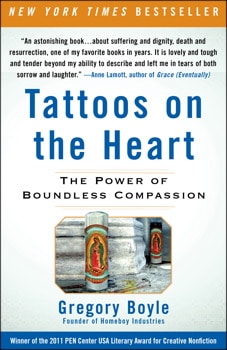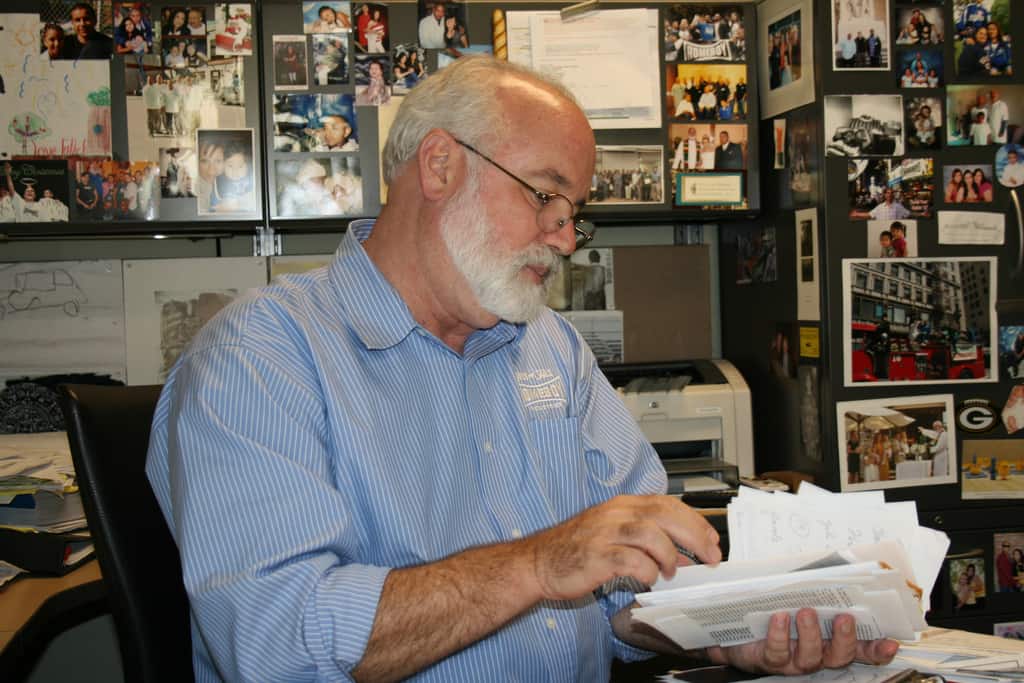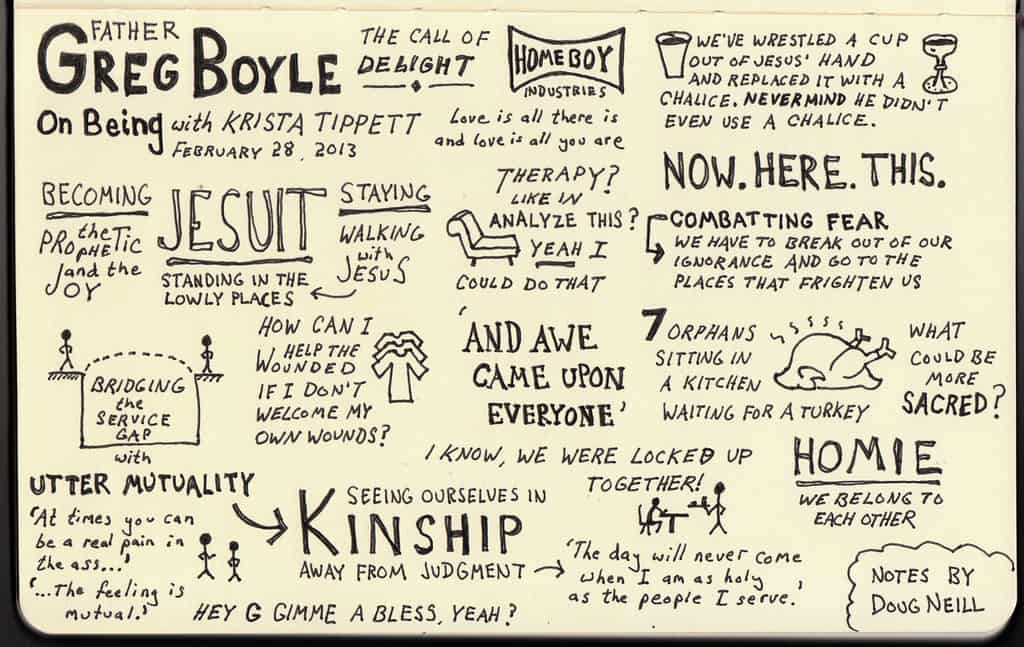The wall of our house chapel is only two short steps from the “interesting” neighborhood outside, and rough words from rough conversations often float in at just the right moments. An “oh hell no” during long homilies sends my wide eyes searching for comedic sympathizers; the rarer “f**k that s**t” amidst prayers-of-the-faithful solemnity merits some muffled giggling even from priests in their 60s. We laugh, buffered by windows and curtains that grant – if only for 30 minutes – a respite from the busy world outside.
A few weeks ago I stepped into that familiar chapel at the regular time only to find something strange in the air. It was a Saturday morning, yet nearly every seat was already filled. A new but recognizable face sat with closed eyes, clearly relishing the dim quiet of morning. As I settled into the chair across from him, his eyes popped open. He turned and offered a warm smile and a hand.
“Greg Boyle. Good to meet you.”
O.M.G.
***
I’d known he was coming for a visit, so it wasn’t a shock. But still. Greg Boyle.
(And yes, I know it’s unseemly to gush over one’s heroes… too bad. But first, a little background for the uninitiated.)
Well beyond the confines of the Catholic world, Fr. Greg Boyle, SJ is a renowned author and speaker, famous for stumbling into the founding of Homeboy Industries in 1992 because he listened (in this case listened to the hopes and fears of his parishioners at Dolores Mission). This poorest parish in the archdiocese of Los Angeles had seen too many of its young men pulled into gang violence in the 1980s, and “Fr. G” responded by working to get them meaningful employment.
“Nothing stops a bullet like a job,” he’s fond of saying, and his care of souls has morphed him from parish pastor to CEO of a diversified corporation. For the past 20 years, Homeboy Industries has employed thousands of gang members. Formerly-rival homeboys work alongside one another silk-screening t-shirts. Another branch of the work, Home Girls Café, hires high-risk women, many of whom were in rival gangs, to work alongside one another waiting tables. Many Homeboy Industries employees turn their lives around – and some do not. To date, Fr. G has presided over nearly 200 funerals of those whose lives were cut short.
As his schedule permits, he travels the country speaking to groups of all stripes about the importance of creating a human kinship so powerful that God recognizes it as God’s own. Often he travels with former gang members, asking them tell their own stories of rehabilitation. His 2011 bestseller Tattoos on the Heart is filled with such testimonials. It moved me like few books have. Reading one story I’d erupt in laughter. Reading the next my eyes would well up. It’s that sort of book.
He is, in a word, an admirable man.
***
“Joe Simmons. Good to meet you,” I said with false cool. I had met him before – really just heard him speak before and read his book – but I managed not to over-share like a tongue-tied fan. Today was graduation day at Cristo Rey Jesuit High School in Minneapolis, which serves great kids who face tough stuff. Our students had read his book, and were floored to learn that he’d be their graduation speaker. But before all the graduation activities over at school, we Jesuits – regulars and famous guest alike – had our usual Saturday morning community Mass.
No big deal.
Kind of.

I felt a little giddy sitting near a living legend. Part of me wanted to barrage him with questions, but a wiser part remembered that that’s not what one does to others before they’ve had coffee. I settled for studying him throughout Mass.
Like my own Irish-English-American father, Greg’s reddened skin was marbled with little brown dots of melanin, betraying days spent under the sun. (We pale Celts go from zero to lobster in 20 minutes of sun.) No doubt a result of Sunday afternoons greeting parishioners on church steps, stretching back to his missionary year working as an associate pastor in Bolivia. Or so I imagined.
Greg’s fingers spread and contracted, circling the whorls of hair on his forearms. These were the fingers that patted backs, consoled grieving mothers, held together the Body of Christ at too many funerals. Or so I imagined.
In the Catholic calendar, this Saturday was also the feast of the Immaculate Heart of Mary, the mother of Jesus, who pondered all manner of painful things in her heart. A whole holy day spent on a mother’s pained worry. I wondered what – who – was passing through Greg’s mind as his fingers swirled upon his crossed arms.
He was dressed formally, but not too. His life experiences had leveled any pretense to vanity. Here was a man who could bridge the worlds of rich and poor, educated and not; the worlds that the best Jesuits navigate without guile or discomfort.
In the quiet of the chapel, Greg’s eyelids and shoulders drooped. These were the shoulders that held up so many in need of support. This was a man who poured himself out physically-spiritually-emotionally. Here he sat, right across from me, breathing deeply, savoring the silence and space of the morning. A saint-in-the-making recharging his spiritual batteries. Or so I imagined.
***
Calm down, Simmons, I tell myself. You’re getting a little dramatic.
It’s easy for me to imagine that those I admire have superhuman strength. It’s easy to imagine that they’re untroubled by monotony, by daily challenges of fatigue, by fear of failure. But anyone familiar with Boyle’s self-effacing style, in writing or in person, can tell you that even the admirable get annoyed and the courageous grow weary. That even the most compassionate heart aches to forgive those who make bad – sometimes tragic – choices.
When Communion comes, Greg passes me the paten first; the chalice follows. One Jesuit – his feet on the ground – to another. The pedestaling of celebrity and giddiness in my belly means nothing here. Here we are equals. Here we are Greg and Joe, separated only by age, experience, a few brown spots on the arms.
“Holy things for God’s holy ones,” our presider says as we partake of communion. The words sink in fast and deep. Suddenly there are tears in my eyes.
***
As soon as Greg handed me the chalice, he ducked out of the chapel, no doubt headed to his first of many obligations. In his sudden absence I felt hollow, uncertain. Was no one else troubled by his sudden departure? Was this what it was like for the Apostles to live in the company of Jesus – to be with him for a long moment… and then he’s gone, whisked back into the thick of humanity? Intimacy followed by sudden departures? The sense of uncertainty that follows?
Now what? I wondered.
“Go and do likewise,” a voice whispered. No, not a voice. A wave of excited calm. A finger-to-lip, skin-tingling a-ha clarity of purpose. A reminder of who I am and why I love the students at Cristo Rey Jesuit High School.
***
It’s taken time to realize, but I don’t admire Greg Boyle because I want to be him; I admire him because he makes me want to be a better me – teacher, Jesuit, lover of the holy ones of God. He refreshes my desire to love deeply, reminds me of the need to immerse myself in silence and recharge when I can. This, I think, is what being a contemplative-in-action is all about. Or, as Greg writes:
Close both eyes and see with the other one. Then we are no longer saddled by the burden of our persistent judgments, our ceaseless withholding, our constant exclusion. Our sphere has widened and we find ourselves quite unexpectedly in a new expansive location in a place of endless acceptance and infinite love.
Sifting our days in gratitude, straining out the role models and a-ha moments that stir our hearts to become holy things for God’s holy ones. Saints and lovers in the making, all of us.



